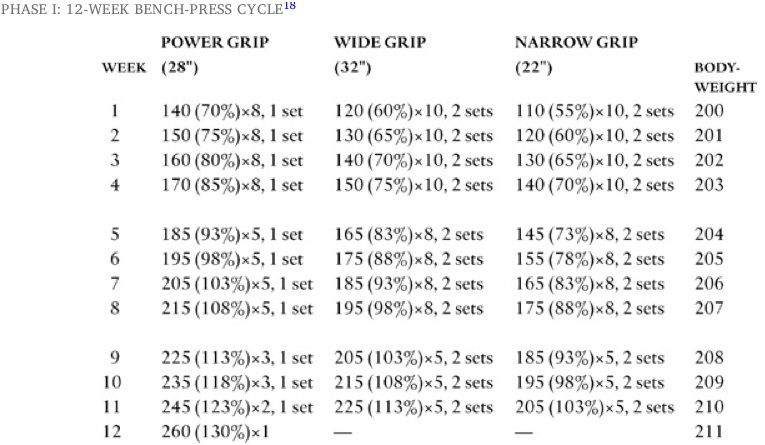EATING THE ELEPHANT
How to Add 100 Pounds to Your Bench Press
Just remember: somewhere in China, a little girl is warming up with your max.
—Jim Conroy, Olympic weightlifting coach f you get to 315, you can change the music on the iPod.”
I laughed again, not getting the joke. But it wasn’t a joke. DeFranco pointed a finger at the wall, where a large piece of paper was taped:
Bench 315?
Squat 405?
Play on ESPN?
If not, don’t touch the iPod!
There was some distance to go before I benched 315. I would have to wait to put Disco Duck on the loudspeakers.
DeFranco’s boys, on the other hand, had no problem with 315. His cadre of beasts included freaks of nature like Rich Demers, who could bench-press 215 pounds for 39 reps. That impressed me.
It impressed me, but it didn’t stun me.
Stunning was Joe Ceklovsky, who has bench-pressed 600 pounds in competition at 148 pounds bodyweight.
Stunning was Scot Mendelson, who has bench-pressed 1,031 pounds in competition at 275 pounds bodyweight.
To put 1,031 in perspective, imagine loading a standard gym barbell with 45-pound plates until no more can fit. That is a measly 885 pounds. Scot has to use 100-pound plates, and the tempered-steel bar literally bends around his hands. He wears a mouth guard so he doesn’t shatter his teeth with jaw tension, and his vision gets pulled out horizontally when the bar pauses at his chest.
These are unusual people. But that’s a compliment. You can learn a lot from the extremes.
Background on the Bench: My Achille’s Heel
The bench press has always been my weakest exercise. Few sports require much of the chest, and my principal sport of wrestling practically made a point of neglecting it.
Even on a steady diet of doubles (sets of two) on Barry’s program, my maximum bench wouldn’t budge. In this, I was an exception.
So I called one of the sages of powerlifting to settle the issue.
Marty Gallagher stays out of the limelight, but has long been in the record books. He has coached some of the most legendary powerlifters of all time, including Ed Coan, Kirk Karwoski, Doug Furness, Mike Hall, and Dan Austin. Coan alone set more than 70 world records. Kirk “Captain Kirk” Karwoski increased the International Powerlifting Federation (IPF) world record for the squat an astonishing 100 pounds during his reign, from 903 to 1,003 pounds, and this world record still stands 16 years later.
Marty is also a three-time master powerlifting world champion and six-time master national powerlifting champion, not to mention that he coached the U.S. powerlifting squad to the IPF world team title in 1991.
Suffice to say, he understands the subtleties of the iron game.
In his words, what follows was his pound-by-pound, workout-by-workout presciption for me, or anyone who wants to add 100 pounds to their current max in six months.
Enter Marty Gallagher
Is it possible for a regular fellow with a 200-pound bench press to add 100 pounds to his bench press in six months? The answer is that, while improbable, it is not impossible. It requires eating the elephant one bite at a time.
There are three requirements:
Requirement #1: A periodized tactical game plan. Periodization is another word for progressive resistance preplanning. Elite powerlifters, Olympic weight lifters, and professional athletes use periodization to stair-step their way upward to ever greater strength levels over a specified time period, usually 12–16 weeks. By expropriating a periodization strategy and applying it to the bench press, the impossible becomes plausible.
Toward the end of his career, Kirk Karwoski never missed a rep in any lift over an entire 12-week cycle. Can you imagine? A man sits down with a pad and pencil 12 weeks prior to a National or World Championship, writes out the projected poundage, reps, and sets for every single session for every workout for the next three months, then never misses a single predetermined rep. Ed Coan and Doug Furness could do the same.
Precision is critical.
Requirement #2: No missed workouts.
Requirement #3: Adding a significant amount of muscular bodyweight.
Let us assume our hypothetical athlete is a fairly serious fitness buff who has several years of progressive resistance under his belt and can already bench-press 200 pounds using proper technique. Regardless if he is 6′1′′ and weighs 200 pounds with a 14% bodyfat percentile or he’s 5′6′′ and weighs 200 pounds with a 30% bodyfat percentile, in order to increase his bench press from 200 pounds to 300 pounds, it is critical to increase lean muscle mass. Our man will need more muscular firepower.
Any “fitness expert” who tells the uninformed that they can add 50% to their bench press in short order with no weight gain by using (or more likely purchasing) some utopian bench-press routine is either delusional or a shyster. There is no magical, mythical exercise routine that will miraculously add 50% to the bench press without a concurrent gain in muscle mass. It takes a 10% increase in lean muscle mass to net a 50% increase in strength, and that’s being optimistic. Period.
Our hypothetical athlete starts off weighing 200 pounds and will need to push his lean muscle mass up 15–20 pounds over a 26-week period.
It’s possible to estimate the grip widths without bringing a tape measure to the gym. Here are several guidelines, keeping in mind that the narrow smooth bands on a standard Olympic barbell are 32 inches apart:
If you are 5′10′′–6′, the power grip will have the edge of your pinkies just inside the rings.
For someone 5′6′′–5′9′′, the power grip will have your hands one hand-width in from the rings.
If in doubt, the power grip is simply the placement that allows you to lift the most weight. Experiment.
For all heights, from the power grip, the wide grip would be one hand-width out in both directions, and the narrow grip would be one hand-width in for both hands.
In this phase I, the athlete jumps his lean muscle mass upward by 11%, resulting in a 30% increase in the bench press. Calories are methodically increased each week, keeping the individual anabolic. How many calories? As many as necessary to provoke the requisite weekly weight gain. How much weight gain? If you weigh less than 200, aim for one pound per week of gain. If you weigh 200+, two pounds per week. There is no hard number of calories—you just need to move the scale up.
Protein must be kept high: 200+ grams per day each and every day.
Now What? Alike Yet Different Experience has shown time and time again that after an athlete has completed a successful 12-week cycle, gains need to be solidified. Engaging in yet another power cycle immediately after a successful initial cycle is doomed to failure. The natural inclination is to be greedy and continue down the same path—that, however, is biological suicide.
Science and empirical data have shown that the body needs 4–6 weeks to reset and regain its physiological bearings. The hypothalamus gland controls bodyweight, body temperature, hunger, thirst, fatigue, and circadian cycles. The interim phase allows the hypothalamus gland to recalibrate and readjust. It is equally important to “get away” from the three bench-press versions used in phase I. We also kick the reps upward.
The ideal interim phase retains bench power by substituting heavy dumbbell pressing for barbell bench pressing. Allowing the body to “forget” the three exercises (competitive grip bench, wide grip bench, and narrow grip bench) makes these movements feel fresh and new when they are reinstituted in phase III, and the training effect is profound.
The paused flat dumbbell bench press and the paused incline dumbbell bench press are the phase II workhorses and are performed together in each workout, once per week. Maintain tension for a one-second pause at the chest; do not relax and rest the weight on the chest.
After the six-week interim phase, all initial gains have been solidified: the athlete’s bodyweight regulation thermostat has been reset, while pushing strength has been retained. The body has “forgotten” flat barbell benching, and when we reinstitute our classical regular/wide/narrow flat bench strategy, the training effect is achieved. Chest, arms, and shoulders are (once again) shocked into growth. More muscle means a bigger bench.
This is how you can, if you don’t miss a thing, add 100 pounds to your bench press in six months.
(Esto que viene a continuación son los pies de página de la foto 1 y de la foto 2)
18. Tim: The percentages are provided to help you personalize the program. Take “140 (70%)×8, 1 set,” for example. 140 is 70% of my starting 200-lb. 1-rep max (1RM). But if your individual 1RM is 150 pounds when starting the program, you would simply multiply 150×0.7 to arrive at 105 lbs. Later in the program, if you see “133%,” it means you multiply 150×1.33 and use the resulting 199.5 lbs. for that set.
19. Please note that all weights are per dumbbell. For example, “60 lbs (60%)” represents 2 × 60-lb. dumbbells, which total 120 lbs., or 60% of the starting 1RM.
 Freak
Freak

 Baneado
Baneado








